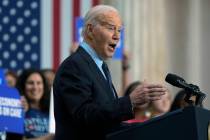COMMENTARY: Nevada lacks transparency with per-pupil spending
As little Johnny and Susie return to school, it’s a good time to ask if they’re getting enough bang for your buck. Do you favor increasing, decreasing or maintaining the level of funding for your local public schools? Does your answer depend on how much those schools are currently spending? Do you know how much that is?
Hint: it’s more than you think, and Nevada’s Department of Education is keeping you in the dark.
In Nevada, the total annual cost per pupil is $9,870 on average, according to the most recent data from the National Center for Education Statistics (2009-10). However, according to the Nevada Department of Education (NDE), the average per pupil cost was just $8,515 that year.
Why the discrepancy? Despite referring to “total per pupil expenditures,” the NDE actually only publishes operating per pupil expenditures, omitting some big-ticket items like paying off debt for school buildings.
That’s one reason Nevada earned an F-minus for financial transparency in a new report from the Cato Institute, “Cracking the Books,” which examines the spending data that all 50 state education departments make available to the public on their websites. The report reveals that very few state education departments provide complete and timely financial data that is understandable to the general public, and Nevada is the fourth worst in the nation; right behind Alaska, Hawaii, and Iowa.
A business that acquired a loan from a bank while understating its expenses would be in serious trouble, yet state education departments like Nevada’s routinely understate the costs of public schools. It’s no wonder that a recent survey by Harvard University found that the public’s average estimate of the annual cost per student in public schools nationwide was less than half what is actually spent.
Numerous states fail to report other key financial data as well. The NDE website fails to provide any data regarding total expenditures, capital expenditures, average salaries, employee benefits, or pensions.
By contrast, New Mexico’s Department of Education earned the report’s only solid A. It provides complete, timely, and accessible spending data, and other states should emulate it.
Financial transparency is essential for sound decision-making. The Harvard survey also examined how misconceptions about education spending affect support for spending levels. The researchers randomly divided survey respondents into two groups. They asked the first group whether “government funding for public schools in your district should increase, decrease, or stay about the same.” They asked the second group the same question but prefaced it by informing respondents how much was currently being spent annually per pupil in their district.
Fifty-three percent of the uniformed group wanted to increase spending on public schools. However, among the informed group, only 43 percent wanted to increase spending, while 57 percent wanted spending to stay the same or decrease.
The widespread underestimation of education spending has real-world consequences. On Election Day 2012 in Colorado, voters in 29 of 31 districts voted to increase K-12 education spending by over $1 billion, approving 34 bond issues and operating revenue increases. The results for nearly two-thirds of the ballot questions passed with less than 60 percent support. As the Harvard survey suggests, a fully-informed public would likely have voted differently.
Voters in Esmeralda and Eureka may be surprised to learn that their annual operating per pupil expenditures last year were $30,089 and $28,369, respectively. Perhaps there are some good reasons that spending is so high in those communities, but voters should have accurate information about how much they’re presently spending before deciding whether to spend more.
When government agencies provide incomplete or misleading data, they deprive taxpayers of the ability to make informed decisions. At a time when state and local budgets are severely strained, it is crucial that spending decisions reflect sound and informed judgment.
Jason Bedrick is a policy analyst with the Cato Institute’s Center for Educational Freedom. He is the author of “Cracking the Books: How Well Do State Education Departments Report Public School Spending?”























